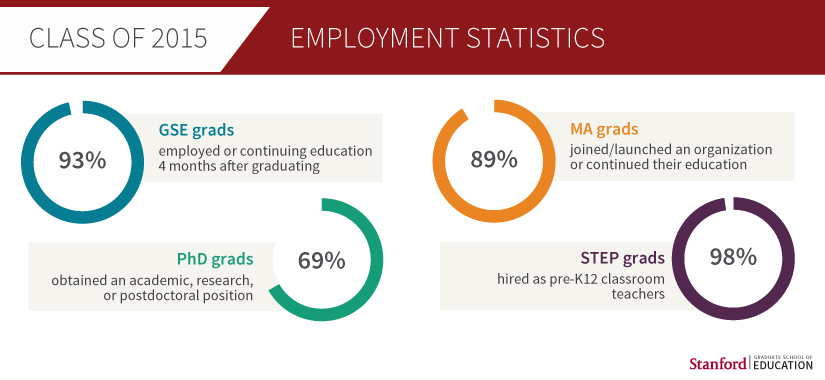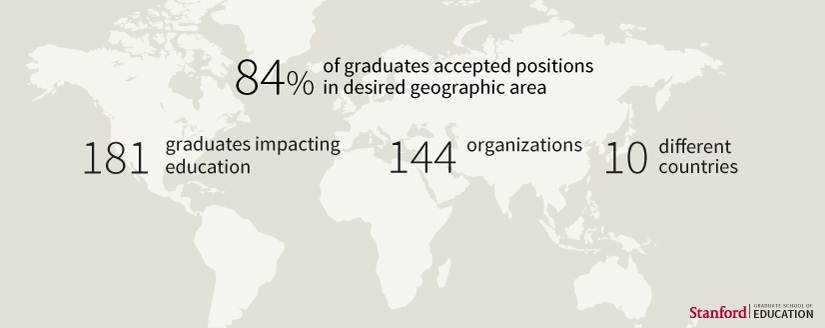
Four months after graduating, nearly all members of Stanford GSE Class of 2015 employed in education
Ninety-three percent of the members of the 2015 Stanford Graduate School of Education (GSE) class — PhD, Stanford Teacher Education Program (STEP) and other MA students — were employed, continuing their educations, or starting a business within four months of graduation and were working at 144 different organizations in 16 states and 10 countries.
The alumni’s job titles include professor, teacher, strategic partnership manager, chief operating officer, data scientist and head of government partnerships, according to the results of an annual survey conducted by Stanford EdCareers, the GSE’s career center. The 2015 employment rate of 93 percent was the same as that of 2014.
The findings, which were published earlier this month, show that almost all respondents who had found employment were working in education-related organizations. Cambodia, Brazil, Finland and Mauritius are among the destinations of the graduates.
In 2015, the GSE awarded 221 degrees: 41 doctoral, 86 master’s in STEP and 94 master’s in other programs that include the study of educational management, educational technology, learning design and international comparative education. The data making up Stanford EdCareers’ yearly report, its fifth, provide a snapshot of how the most recent crop of GSE graduates are fulfilling their aspirations while impacting the broadening educational employment landscape.
Christine Moon, who graduated from STEP in 2015, is among the 93 percent of respondents who found employment. She accepted a job teaching kindergarten at Lakewood Elementary School in Sunnyvale, Calif., where she had interned during STEP. Moon grew up wanting to be a sociologist and majored in the discipline until she fell in love with being in a classroom.
Moon also is among the 34 percent of 2015 responding STEP graduates whose student teaching experience led to a job with the same employer. Moon said her interest in sociology and GSE classes focusing on social justice reinforced her decision to accept a job in a low-income, low-resource school.

By contrast, Haley Robison, another survey respondent, used her GSE experience to find work promoting “informal learning” — outside classrooms and beyond schools.
Robison received her MA in education from the GSE and her MBA from Stanford Graduate School of Business through the Joint MA/MBA program. Influenced by her work designing business curriculum during her last summer internship, she became interested in experiential learning. Through networking and some serendipity, she was offered a job as chief operating officer of Kammok, a six-year-old, socially conscious outdoor gear, apparel and adventure company whose mission is to encourage life-changing experiences and education through the lens of nature.
“I am passionate about alternative forms of education that are experiential and applied. Much of the work we do is through the lens of education. My goal at Kammok is to bridge the outdoor experience with educational content,” said Robison, who was an outdoor adventurer even before her new job.
Nereyda Salinas, director of the GSE’s career center, said the ways Moon and Robison went about figuring out what careers resonated with them reflect the points of Stanford EdCareers coaching model. It counsels GSE students to guide their employment decisions through knowledge of themselves and their values, networking and interning to connect with potential employers, and surveying all employment avenues — even those, such as Kammok that are not patently education organizations. [For more on the EdCareers coaching model, see pages 2 and 5 in the report.]
Salinas also noted that Moon and Robison are happy with the geographic location of their jobs — an often overlooked statistic that is nonetheless important to graduates.
Among the study’s findings are that 90 percent of STEP graduates and 79 percent of the other master’s grads took jobs where they wanted to live. Perhaps most notable, 75 percent of the PhD grads reported being happy with their location, “which is a great statistic, considering that academic job markets can be very competitive and this often prevents PhDs from finding employment in their most desired location,” said Salinas.

The job placement of 2015’s responding PhDs was strong, though down 2 percent from 2014. The survey revealed that, of those 2015 PhD respondents seeking positions, 95 percent had accepted a job within four months, with 86 percent of those in the education field.
The doctoral graduates reported being hired within four months of graduation by 27 different organizations. Nearly half accepted a faculty or postdoctoral position — at Stanford University, the University of California and Temple University, among others. Other employers included Airbnb, Facebook, and McKinsey & Company. The respondents’ median salary was $73,000 with a range from $44,000 to $175,000.
The median full-time salary for responding STEP graduates was $54,553 and the salary range was $38,000 to $73,000. Most teacher salaries are set by a district and are not individually negotiated.
STEP is a 12-month course of study that leads to a Master of Arts in Education and requires a 12-month teaching practicum. Elementary school teachers receive a California Preliminary multiple subject teaching credential; secondary graduates earn a California Preliminary single subject teaching credential. Two 2015 STEP graduates used their degrees to take jobs in Massachusetts; one is teaching in South Carolina.
The 2015 EdCareers report revealed that 98 percent of the STEP alumni were employed within four months of graduation and all of the employed graduates had accepted a position in the field of education. All were also employed as PreK-12 teachers. Seventy-five percent were teaching at a public (non-charter) school. Sixty percent of those have assumed school or district leadership positions outside their classrooms.
Like STEP grad Christine Moon, classmate Jeffrey Charles Dong took a job in a California public school. He teaches math to freshmen and sophomores at Del Mar High School in Campbell. He impressed his future employers while participating in mock interview sessions organized by STEP for its students.
“I trusted the connections and suggestions of STEP and GSE advisors; they were invaluable in securing the job I desired,” Dong said.
In addition to STEP, the GSE has four other MA programs including International Comparative Education/International Education Policy Analysis; Learning, Design and Technology; Policy, Organization and Leadership Studies; and Curriculum and Teacher Education. There also are three joint degree programs that offer MAs in education in conjunction with degrees from Stanford Law School, Stanford Graduate School of Business and Stanford’s Public Policy Program.
Patrick Curry, who graduated with a MA in International Comparative Education, also reported that a data analysis internship at Room to Read, an international literacy-building organization, led to his employment as associate manager of its Southeast Asia Literacy Program, managing curriculum development teams in Cambodia, Laos and Vietnam. Curry was among the 66 percent of 2015 MA grads (non-STEP) who interned during their masters’ programs.
The 2015 EdCareers survey showed the highest percentage ever for MA degree recipients (not including STEP) who were employed, continuing their education or had started a new organization within four months of graduate over previous years. Eighty-nine percent were in that category in 2015 compared with 84 percent in 2012, 78 percent in 2013 and 85 percent in 2014.
Like Curry, 66 percent had completed at least one internship and 31 percent of those said the internship, directly or indirectly, led to a position upon graduation.
The Stanford EdCareers survey was administered to the Class of 2015 graduates electronically via Qualtrics, at graduation. Those indicating they were “still seeking a position” at graduation received a follow-up survey four months later. The survey closed in December 2015 with a response rate of 92 percent for all graduates.
In addition, a “knowledge rate” based on email, faculty contacts or LinkedIn profiles was calculated for 12 percent of the graduates who did not respond to either inquiry. The knowledge rate is based on information sent via email, faculty contacts or LinkedIn profiles. The total knowledge and response rate is 96 percent.
For a quick view of the results, please see the EdCareers summary graphic. That fact sheet and the full reports for the past five years are available on the Alumni Career Impact web page.
Joyce Gemperlein, a freelance writer in the Bay Area and a former Knight Fellow at Stanford, is a contributor to the Stanford Graduate School of Education website and the school's e-newsletter, The Educator. Please read our previous issues and subscribe.



